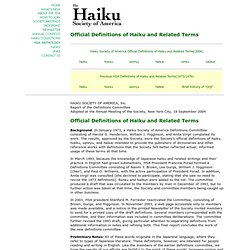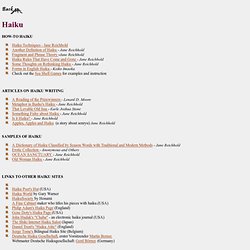

Start Writing Haiku. There are many different ways to go about writing HAIKU. You can listen to classic works, read detailed instructions or just jot down three short lines. The master Masaoka Shiki told his disciples that they had only to look carefully at one scene in nature to be able to produce over 20 HAIKU. Shiki wrote tens of thousands over his short lifetime of 36 years. Many are excellent and as vibrant and full of meaning today as when they were written.
Haiku. Haiku (俳句, haikai verse?)

Listen (no separate plural form) is a very short form of Japanese poetry typically characterised by three qualities: Modern Japanese haiku (現代俳句, gendai-haiku?) Are increasingly unlikely to follow the tradition of 17 on or to take nature as their subject, but the use of juxtaposition continues to be honored in both traditional and modern haiku.[4] There is a common, although relatively recent, perception that the images juxtaposed must be directly observed everyday objects or occurrences.[5] Haiku: History. Haiku Society of America.
Haiku and Senryu. Helpful Hints 1) Haiku is generally not written in one long run on sentence.

It is generally written in two parts. You have a fragment on the first or the last line, then you have the body of the haiku. Example: winter sun-- a cyclist pedals against the wind Copyright © 2000 Kathy Lippard Cobb, April 2001 Heron's Nest. Senryuu vs Haiku. Association Française de Haiku. Haiku et Sengai. 100%haiku. Anthologie du haïku. Basho's Haiku. Simply Haiku: A Quarterly Journal of Japanese Short Form Poetry. Welcome to Modern Haiku. Haiku Society of America. HAIKU SOCIETY OF AMERICA, Inc.

Report of the Definitions Committee Adopted at the Annual Meeting of the Society, New York City, 18 September 2004 Background. In January 1973, a Haiku Society of America Definitions Committee consisting of Harold G. Henderson, William J. Higginson, and Anita Virgil completed its work. In March 1993, because the knowledge of Japanese haiku and related writings and their practice in English had grown substantially, HSA President Francine Porad formed a Definitions Committee consisting of Naomi Y. In 2003, HSA president Stanford M. Preliminary Notes: All of these words originate in the Japanese language, where they refer to types of Japanese literature. In 1973 the Haiku Society of America was the only substantial non-Japanese haiku organization, and virtually all public statements about haiku in English were made in the pages of a few books and low-circulation magazines.
Go to Top Definition: A hokku is the first stanza of a linked-verse poem. Go to Top. How to write a Haiku: Description and explanation of the Haiku, The Haiku Verse Form by J.

Zimmerman. Mushimegane - Haïku, Tanka, et Art Contemporain. Haiku, Haibun, Haiga, Photohaiku, Arthaiku. Haikuspirit. Japon. Basho's Haiku. Haiku. Haiku ( 俳句) listen is a kind of Japanese poetry.

It was given this name in the late 19th century by a man named Masaoka Shiki by a combination of the older hokku ( 発句) and the haikai (or verses) in haikai no renga. Haiku, when known as hokku were the opening verses of a linked verse form, haikai no renga. In Japanese, hokku and haiku are traditionally printed in one vertical line (though in handwritten form they may be in any reasonable number of lines). In English, haiku are written in three lines to equate to the three parts of a haiku in Japanese that traditionally consist of five, seven, and then five on (the Japanese count sounds, not syllables; for example, the word "haiku" itself counts as three sounds in Japanese, but two syllables in English, and writing seventeen syllables in English produces a poem that is actually quite a bit longer, with more content, than a haiku in Japanese). Syllable or "On" in Haiku 古池や蛙飛込む水の音 This separates into on as: furuike ya (fu/ru/i/ke ya): 5.
Kigo. The use of kigo is very problematic in Western haiku. It has been proposed by many poets, that kigo is not possible over a great geographic range. However Japan is also spread over a great geographic range and the kigo problem is overcome by having different season word dictionaries ("saijiki") for different climates. eg Hokkaido Saijiki, Okinawa Saijiki, Brazil Saijiki, Hawaii Saijiki. Haiku. Agnieszka's Dowry (AgD) ISSN 1088-4300. Haiku. Perhaps, nothing is absolute in haiku.

Like life, haiku require learning, experience and balance. I hope today you have learned a bit more of one technique - the use of fragment and phrase. Blessed Be! Jane Reichhold The fact that the smallest literary form - haiku - has the most rules never ceases to amaze and astound. To write about one or two 'rules' as if these are the 'real rules' could (and should!) First and foremost, and certainly the guideline which I have consciously or unconsciously followed the longest, is the one that a haiku must be divided into two parts. For purposes of this discussion, I would like to call the shorter portion, the fragment and the longer portion, or rest of the poem, the phrase.
The need for distinguishing between the two parts of the ku takes on importance when one begins to discuss the use of articles (a, an, & the) because it is possible to have different rules concerning the different parts. A vegetarian with legs crossed in zazen the roasting chicken. Chez Marylène. Mushimegane - Haïku, Tanka, et Art Contemporain. France. Association Française de Haiku. Chaba: An Electronic Haiku Journal. This page was taken from John Hudak's "Chaba - An Electronic Haiku Journal". I've added a couple of comments of my own at the end of this essay. Haiku Is What? By L. A. Davidson Reprinted with permission from Feelings Magazine , Volume 7, No. 3, Spring 1996 Many of the thousands of poets outside Japan studying and writing this brief form in English and other languages know what haiku was : that it originated in Japan, had a set form of 5-7-5 Japanese symbol-sounds, and was related to nature.
And most are becoming aware that it will be an accepted form of poetry for time to come, as long as people react to their environment with the perception of what is occurring at the moment, concisely without embellishment. But to state in simple terms what haiku is will cause a hail of cliches and a fog of often contradictory or confusing opinions, rules, and lists of "do" and "don't.
" The falling leaves fall and pile up; the rain beats on the rain (Gyodai, 1732-93, tr. Even here, R.H. (tr.